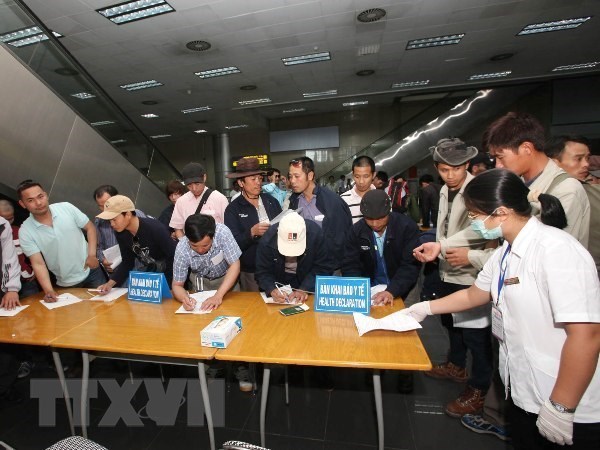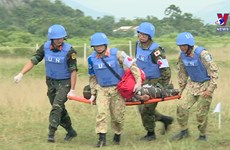Handbook introduced for improvement of migrant health
A migrant health handbook, which provides basic information, advice and guidance for health needs of migrant workers, was introduced at a workshop held by the General Office for Population and Family Planning (GOPFP) in collaboration with the International Organisation for Migration (IOM) in Vietnam in Hanoi on July 18.
 Vietnamese guest workers returning from Lybia arrive at Hanoi's Noi Bai International Airport. (Photo: VNA)
Vietnamese guest workers returning from Lybia arrive at Hanoi's Noi Bai International Airport. (Photo: VNA)Addressing the event, GOPFP Director General Nguyen Doan Tu said migration is a global phenomenon, with around 281 million international migrants worldwide; 48% of whom were women and 60% were migrant workers.
Vietnam’s population has reached 98 million, ranking 15th globally, eighth in Asia and third in ASEAN, Tu said. The country's working-age population, aged 15 – 64, is estimated at some 66.6 million, or 68% of the total, he noted, adding that though such a large workforce brings various opportunities for Vietnam’s socio-economic development, it has profound impacts on migration flows in the country.
He described migrants as a vulnerable group of people, noting that migrants, particularly international ones, often face numerous challenges in the host destinations when it comes to languages, culture, lifestyle, legal knowledge, family separation and others.
Lack of access to medical services also affects their lives, physical and mental health, according to Tu. Healthy migrants can be crucial workforce for the well-being of businesses and the economy as a whole, he said.
The migrant health handbook was initiated by a technical group for migrant health in Vietnam established by the Ministry of Health. It was developed with advice from specialists from the Republic of Korea and Japan with the support from the IOM in Vietnam.
The Question & Answer handbook offers fundamental knowledge on Vietnam’s health system; social security and health insurances; as well as advice and guidance on occupational safety; prevention of communicable diseases; reproductive health; mental health; building a healthy lifestyle; support and protection of oversea migrants; and others.
The digital version of the handbook will be released in the coming time and constantly updated to stay relevant with Vietnam’s changing situation.
A similar handbook for Vietnamese migrants living in different foreign countries will also be developed.
Mihyung Park, Chief of Mission at IOM Vietnam, highly spoke of the country’s efforts in ensuring the well-being of Vietnamese migrants overseas at the time of COVID-19. IOM has discussed with concerned parties in Japan and the RoK about establishing a platform for cooperation in protecting health of Vietnamese migrants and feedback has been positive.
About 600,000 Vietnamese migrants are living and working in more than 40 countries and territories worldwide. Remittance to Vietnam was estimated at around 3 – 4 billion USD annually./.













